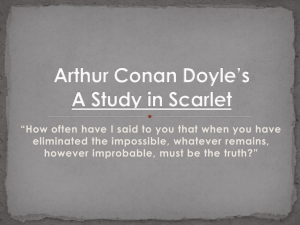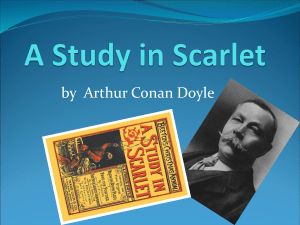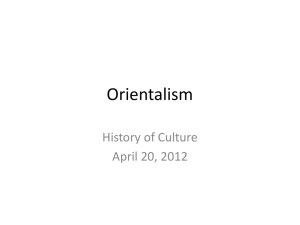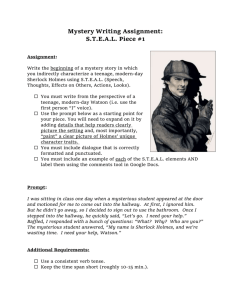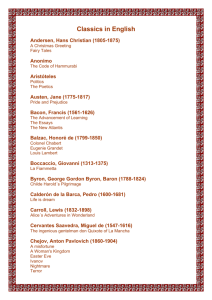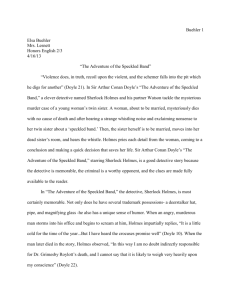THE APOLLONIAN
advertisement
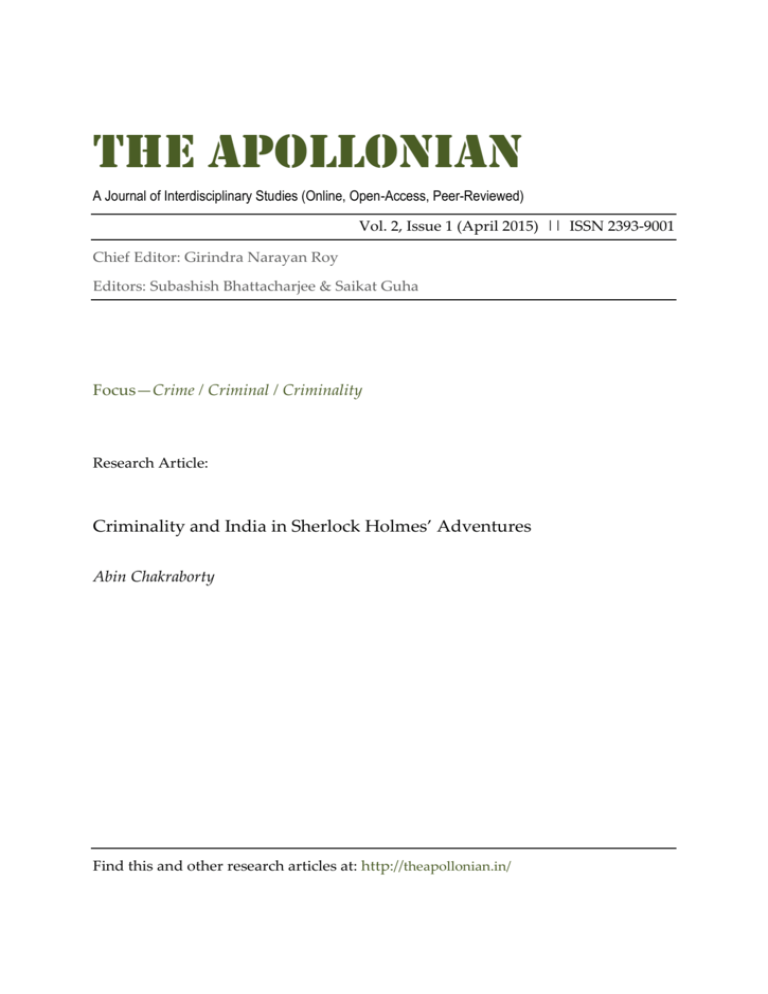
THE APOLLONIAN A Journal of Interdisciplinary Studies (Online, Open-Access, Peer-Reviewed) Vol. 2, Issue 1 (April 2015) || ISSN 2393-9001 Chief Editor: Girindra Narayan Roy Editors: Subashish Bhattacharjee & Saikat Guha Focus—Crime / Criminal / Criminality Research Article: Criminality and India in Sherlock Holmes’ Adventures Abin Chakraborty Find this and other research articles at: http://theapollonian.in/ The Apollonian 2.1 (April 2015) 16 Criminality and India in Sherlock Holmes’ Adventures Abin Chakraborty Chandernagore College, Burdwan University, India Adventure narratives since the sixteenth century have been entangled with imperial ideologies and consequent representation of the colonies and the colonized. Whether it is Aphra Behn’s Oroonoko or Defoe’s Robinson Crusoe or the narratives of Rider Haggard – representation of colonized lands and their inhabitants have appeared and reappeared in the literary landscape as part of a growing imperial culture whose hegemonic inclinations manifested themselves through cultural representations of one kind or another. Such representations aided the ideological control of an imperial culture which thrived on the basis of a pervasive discourse that posited the native as being racially inferior, endowed with bestial and criminal tendencies, the colonized lands as being sources of physical, moral or spiritual contamination and the white man in the colonies as the stern pioneer of order, progress and prosperity. The discourse of Orientalism, as Edward Said has demonstrated obviously played a key role in the formation of this imperial culture through its inaccurate and derogatory representations of the orient, circulated through texts, paintings and other cultural artifacts. Sir Arthur Conan Doyle’s adventures, involving the great investigator Sherlock Holmes and his friend Dr. Watson, are also shaped, both by imperial assumptions and orientalist stereotypes, as evident from several textual examples, in different novels and stories. The paper would go on to analyse, with several examples, how, in these adventures, we encounter derogatory representation of the native as criminal, prejudiced portrayal of Indian colonial history and the depiction of the colonies, especially India, as a source of moral and psychological contamination. Orientalism and Victorian Culture: Edward Said, in his seminal text Orientalism, defines it as a discourse which may be perceived as ‚a distribution of geopolitical awareness into aesthetic, The Apollonian 2.1 (April 2015) 17 scholarly, economic, sociological, historical and philological texts‛ (Orientalism 12) which functioned on the basis of ‚the ineradicable distinction between the Western superiority and Oriental inferiority‛ (Orientalism 42). While this particular discourse has indeed developed in different ways over centuries, what makes the nineteenth century remarkable in this context is the emergence of what Said would later define as latent Orientalism: Now, one of the important developments in nineteenth century Orientalism was the distillation of essential ideas about the Orient – its sensuality, its tendency to despotism, its aberrant mentality, its habits of inaccuracy, its backwardness – into a separate and unchallenged coherence […] an almost unconscious (and certainly untouchable) positivity […] (Orientalism 206) This was a crucial development of the fundamental binary opposition between Europe and the Orient as the ‘self’ and its ‘other’ which underlies Orientalism and Said himself pointed out how such a development, combined with prevalent theories of racial distinction, biological determinism and second-order Darwinism, led to a conjunction between Orientalism and various forms of degeneracy and criminality (Orientalism 206-207). Significantly, such a development easily evolved into an equation of the Orient with otherized sections of the West. As Said states, ‚The Oriental was linked thus to elements in the western society (delinquents, the insane, women, the poor) having in common an identity best described as lamentably alien‛ (Orientalism 207). These aspects of latent Orientalism found various avenues through which they became a part of manifest Orientalism and literature certainly acted as one of the prime avenues. As Said himself reminds us in Culture and Imperialism, Nearly everywhere in nineteenth and early-twentieth century British and French culture we find allusions to the facts of empire, but perhaps nowhere with more regularity and frequency than in the British novel. Taken together these allusions constitute […] a structure of attitude and reference. *…+ In all of these instances the facts of empire are associated with sustained possession, with far-flung and sometimes unknown spaces, with eccentric or unacceptable human beings, with fortune-enhancing or fantasized activities like emigration, money-making and sexual adventure. (Culture 73-75) As Said’s own analysis has shown, the pervasive influence of such colonial discourses are as much discernible in the novels of Austen or the Brontés, with their typical English settings, as they are in those of Kipling or Conrad, many of whose texts are set in the colonial outposts. The one thing that remains common, despite The Apollonian 2.1 (April 2015) 18 other differences, is that all of them ‚extolled the empire and stressed its necessity to England's strategic, moral and economic well being, at the same time characterizing the dark or inferior races as unregenerate, in need of suppression, severe rule, indefinite subjugation *…+‛(Culture 181). Arthur Conan Doyle’s Sherlock Holmes narratives emerged out of a similar context and offered a representation of criminality and colonies that entirely matched the imperial figurations generated by latent Orientalism. The following sections would illustrate these assertions by tracing the connection between criminality and India in some of these narratives. India and Sherlock: Empire makes its presence felt in the world of Sherlock Holmes from its very outset. Dr. Watson, after all is a veteran of the Fifth Northumberland Fusiliers who participated in the second Anglo-Afghan War. His accounts not only introduce us to the ‚murderous Ghazis‛ of Afghanistan but also the ‚enteric fever, that curse of our Indian possessions‛ (Doyle 16). Not only does it emphasize the typical Orientalist assumption which vilifies the victorious Afghan opponents of the British but also points to Dr. Watson’s identification with imperial discourse. This identification is something which the Holmes universe as a whole shares, as evident from a number of references to colonies like India and the colonial ties behind some of the crimes Holmes investigates. The first and most obvious reference, in this context, would be to ‚The Sign of Four‛ and the character of Tonga, the aborigine from Andaman who murders Bartholomew Sholto with a poisoned dart. Holmes identifies him first as an Andamanese native by citing the following lines from a volume he claims to be the latest authority on the subject: The aborigines of the Andaman Islands may perhaps claim the distinction of being the smallest race upon this earth, though some anthropologists prefer the Bushmen of Africa, the Digger Indians of America, and the Terra del Fuegians. The average height is rather below four feet, although many fullgrown adults may be found who are very much smaller than this. […] They are naturally hideous, having large, misshapen heads, small fierce eyes, and distorted features. Their feet and hands, however, are remarkably small. So intractable and fierce are they, that all the efforts of the British officials have failed to win them over in any degree. They have always been a terror to shipwrecked crews, braining the survivors with their stone-headed clubs or shooting them with their poisoned arrows. These massacres are invariably concluded by a cannibal feast. (Doyle 128-29) The Apollonian 2.1 (April 2015) 19 Such remarks are steeped in that concoction of racism, craniotomy, phrenology and anthropology which often contributed to the colonial construction of criminality, especially in the colonies. As Preeti Nijhar explains, especially in the context of India, Through taking their own identity from the new sciences, Westerners became bound in their own being under the conditions, rules and values with which they oppressed others. In this all-defining project, the non-Western in imperial India and similarly in the metropolis was scientifically constructed as mysterious, belonging to an unknown savage, located at an unknown time and place. The saved were the Westerners in whom truth and light was reflected. (Nijhar 76) This same savagery is also evident from the portrayal of Tonga in ‚The Sign of Four‛. This is particularly evident from the following passage which registers Watson’s first impression of the Andamanese islander. It straightened itself into a little black man–the smallest I have ever seen–with a great, misshapen head and a shock of tangled, dishevelled hair. Holmes had already drawn his revolver, and I whipped out mine at the sight of this savage, distorted creature. He was wrapped in some sort of dark ulster or blanket, which left only his face exposed, but that face was enough to give a man a sleepless night. Never have I seen features so deeply marked with all bestiality and cruelty. His small eyes glowed and burned with a sombre light, and his thick lips were writhed back from his teeth, which grinned and chattered at us with half animal fury. (Doyle 139) Doyle’s description of Tonga matches the physiognomic signs of civilisational degeneration or backwardness which had been pointed out by eighteenth century authors like Buffon or Blumenbach, nineteenth century successors like Robert Knox or James Hunt and most significantly the evolutionary writings of Spencer, Huxley and Galton (Nijhar 61-74), especially in its emphasis on the smallness of size, the thick lips and the apparently ‘misshapen’ head. Such details also conform to Havelock Ellis’ categorization of criminals on the basis of certain physical details which resemble their closeness to animals as they form an atavistic sub-class among humans. In this regard, Ellis also mentions, This insensibility shows itself in disvulnerability, or rapid recovery from wounds, first pointed out by Benedikt, which appears to be a frequently observed phenomenon among criminals. […] In this respect the instinctive The Apollonian 2.1 (April 2015) 20 criminal resembles the lower animals as well as the lower races of man; among the Egyptians, Chinese and Annamites, and other races, wounds heal much more rapidly than in Europe. (Ellis 125) Through Doyle’s account, with its documentation of ‚half-animal fury‛, even before we come to an explanation of how the central crime in question had occurred, Tonga’s criminality, in keeping with contemporary discourses, has become physically inscribed and he has been relegated to the domain of ‚bestiality and cruelty‛. Significantly, Ellis had also referred to the ‚extraordinary and ape-like agility‛ and the prevalence of prehensile feet (Ellis 117) among the criminals and Tonga’s ability to climb like a cat also becomes emblematic of such typically animal features. In the process, Tonga emerges as a typical product of the contemporary discourse of racially inflected criminal anthropology. What is also remarkable is the role of Jonathan Small, Tonga’s lord, in the representation of his loyal servant. Even before he comes to any description of Tonga’s role in the crime, we are informed about how they ‚earned a living at this time by my exhibiting poor Tonga at fairs and other such places as the black cannibal. He would eat raw meat and dance his war-dance‛. Doyle thus reinforces the earlier reference to the cannibalism of the Andamanese and also illustrates the dehumanizing commodification of the colonized natives which had been popular in England since the sixteenth century, as evident from references in either Shakespeare’s Tempest or Aphra Behn’s Oroonoko. However, when he refers to Bartholomew Sholto’s death at the hands of Tonga, he clearly states that he did not intend for that to happen and that the murder was the native’s own decision: ‚Tonga thought he had done something very clever in killing him, for when I came up by the rope I found him strutting about as proud as a peacock. Very much surprised was he when I made at him with the rope’s end and cursed him for a little bloodthirsty imp‛ (Doyle 157). Doyle’s textual strategy thus absolves the white man of the crime of murder and serves to reinforce the supposedly congenital evil of the colonized native who is even defined as a ‚hell-hound‛. Surprisingly, neither Holmes nor anyone else ever seems to doubt the veracity of Small’s narrative in any way as everyone seems to share a belief in the barbaric viciousness of the native as well as the redeemable quality of a white man, whatever his crimes may have been. However, Tonga is not the only Indian criminal in the novel. The entire prehistory of the Agra Treasure, including the episode of the ‘mutiny’ include various other examples of Indian criminality, as perceived through Doyle’s Orientalist and imperial gaze. Small’s account of the Rebellion of 1857 obviously The Apollonian 2.1 (April 2015) 21 classifies it as a ‘mutiny’ and then goes on to attribute to the rebels the utmost imaginable villainy and evil. With typical colonialist bias, not only does he erase the valid sense of injustice and discontent which the natives felt, but identifies the rebels as ‚two hundred thousand black devils let loose‛ who turned India into a ‘hell’ (Doyle 145). Such entrenched racial prejudice and hatred is again evident when Doyle brings in the reference to the controversial massacre at Kanpur (or Cawnpore) and reinforces the supposed murderousness of the rebels by portraying the horrid death of Dawson’s wife: ‚[…] the cold struck my heart when I found it was Dawson’s wife, all cut into ribbons and half eaten by jackals and native dogs‛ (Doyle 145). The danger to British women in India served in Victorian literature as a potent symbol of what historian Charles Ball defined as the ‚indescribable barbarity‛ (Chakravarty 37) of the rebels who were supposedly guilty of perpetrating, what a later novel would describe as, ‚a horror beyond endurance‛ (Gray 1: 166). While many of these representations were ‚fictions of an excited imagination‛ (Kaye 2: 373), they continued to circulate in fictional and non-fictional narratives surrounding the events of 1857 and contributed to the consolidation of racial hatred against ‚that inferior and subject heathen race they had been accustomed to hold cheaply‛ (Gray 1: 166). The same admixture of racial contempt against a supposedly inferior race and accounts of their unredeemed barbarity, savagery or ferocity is seen in Doyle’s representation of characters like Mahomet Singh, Abdullah Khan or Dost Akbar. The primary force behind the acquisition of the Agra Treasure is betrayal – Dost Akbar promises to secure a safe shelter for Achmet the merchant only to lead him to his murder. During his subsequent pursuit of Achmet for the murder, he is also shown to be ‚bounding like a tiger‛ (Doyle 150). In a similar vein Small also refers to the ‚wild punjabees‛ (Doyle 149) who even threatened to kill him if he did not become a party to the conspiracy. These individual characters are microcosmic representatives of that chaotic macrocosm which is represented either by the ‚yells and howls of the rebels, drunk with opium and with bang‛ (Doyle 147) or the city of Agra, ‚swarming with fanatics and fierce devil-worshippers of all sorts‛ (Doyle 146). Such remarks are characteristic of the dominant racial discourse within which the text functions. What is all the more remarkable is the Punjabi conspirators’ reason for trusting Small, in lieu of a fellow Indian: The thing stands thus, sahib, and I tell it to you because I know that an oath is binding upon a Feringhee, and that we may trust you. Had you been a lying Hindoo, though you had sworn by all the gods in their false temples, your The Apollonian 2.1 (April 2015) 22 blood would have been upon the knife and your body in the water (Doyle 148). To the apparently fierce and bestial nature of the native is thus added the attribute of habitual deception, which further reinforces Doyle’s representation of the congenital evil associated with the Orient. The same pattern again reappears in ‚The Crooked Man‛ which also refers to the ‘mutiny’. Henry Wood’s narration not only refers to the contemporary condition of India as ‚all hell was let loose‛ but even describes the rebels ‚as a set of terriers round a rat-cage‛ (Doyle 420). The recurrence of the animal register once again illustrates the pervasive nature of racial hatred which is further reinforced by the narration of the tortures Wood had to endure after being captured by the rebels and how the rebels themselves were killed by hill-people in Darjeeling who then subjected Wood to their slavery. Such references to ruthless murder, torture and deceit again emphasise Patrick Brantlinger’s argument that contemporary representations of India, during and after the events of 1857, displayed […] extreme forms of extropunitive projection. The racist pattern of blaming the victim expressed in terms of an absolute polarization of good and evil, innocence and guilt, justice and injustice, moral restraint and sexual depravity, civilization and barbarism (Brantlinger 199-200). It is but natural therefore that in ‚The Sign of Four‛ Bartholomew Sholto’s Indian butler Lal Rao would act as an accomplice of Jonathan Small and thus contribute to his master’s murder. ‚The Sign of Four‛, in the process, emerges as a text which is not only steeped in typically racist and Orientalist details but as one which makes an explicit connection between criminality and non-western origins within the diverse locations of empire. Even when Oriental characters are themselves not present, the Orient continues to function as a source of corruption and contamination which functions as the root of other crimes in the metropolitan centre of London. As Mari Isokoski states, in the Sherlock Holmes adventures, ‚degeneration, regression and immorality derive from the colonies‛ (Isokoski 36). This is evident from the representation of Dr. Grimsby Roylott in ‚The Speckled Band‛ and Colonel Sebastian Moran in ‚The Adventure of the Empty House‛. Both of these individuals, despite hailing from notable aristocratic families, turn to violent crimes and in each case, the degeneration may be attributed to their stints in India. Dr. Grimsby Roylott of ‚The Speckled Band‛, who had practiced as a doctor in Calcutta, is found guilty of murdering one The Apollonian 2.1 (April 2015) 23 of his step-daughters with the help of an Indian swamp-adder in his possession. In her description of her stepfather Helen Stoner states, But a terrible change came over our stepfather about this time […] he shut himself up in his house and seldom came out save to indulge in ferocious quarrels with whoever might cross his path. Violence of temper approaching to mania has been hereditary in the men of the family, and in my stepfather’s case it had, I believe, been intensified by his long residence in the tropics. (Doyle 260; emphasis added) As Mari Isokoski explains, ‚From the evolutionary anthropologistic point of view, Roylott has been contaminated by India, his unconscious primitiveness and deviance has surfaced and he has degenerated to an earlier stage of human development and shed his western civilization‛ (Isokoski 47). Similar degeneration is also witnessed in the character of Colonel Sebastian Moran, Moriarty’s accomplice and ‚The second most dangerous man in London‛ (Doyle 494) according to Holmes, who, after studying in Eton and Oxford had served in the Indian army and was famous for being a great big game hunter. Explaining his transformation Holmes states, Up to a certain point he did well. He was always a man of iron nerve, and the story is still told in India how he crawled down a drain after a wounded maneating tiger. There are some trees, Watson, which grow to a certain height, and then suddenly develop some unsightly eccentricity. You will see it often in humans. *…+ Whatever the cause, Colonel Moran began to go wrong. (Doyle 494) The obvious implication is that his turn to criminality was a result of the climatic and cultural contamination caused by the Orient, as had seemingly happened in case of Dr. Grimsby Roylott. Significantly, just as Dr. Roylott’s evil nature was evident from his ‚large face, seared with a thousand wrinkles, burned yellow with the sun, and marked with every evil passion‛ (Doyle 264), Colonel Moran too is endowed with a ‚tremendously virile and yet sinister face‛ (Doyle 492) which was marked by ‚the brow of a philosopher above and the jaw of a sensualist below‛. It could well be argued that just as the sun-burnt face of Dr. Roylott may be seen as a sign of Oriental influence, the sensualist jaw of Colonel Moran may also be seen in a similar light since the Orient often operated as a realm of unrestrained sensuality to the European imagination. This physical assimilation of the Orient becomes even more evident when the narrator observes that ‚With his savage eyes and bristling moustache he was wonderfully like a tiger himself‛ (Doyle 492). A related image occurs elsewhere in the text where Dr. Watson wonders about ‚what wild beast *they+ were about to The Apollonian 2.1 (April 2015) 24 hunt down in the dark jungle of criminal London‛ (Doyle 488). Seen in relation to the imagery of the hunter and tiger, later used in the text, such a representation of the detective’s pursuit of the criminal almost becomes a rhetorical parallel to the coloniser’s attempt to tame and conquer the supposedly wild and savage colonized terrains. The same logic reasserts itself in ‚The Bruce-Partington Plans‛ where, commenting on the usefulness of the London fog for the criminals, Holmes states: ‚The thief or the murderer could roam London on such a day as the tiger does the jungle, unseen until he pounces, and then evident only to his victim‛ (Doyle 913) Within this imperial frame of reference, the hunt for the criminal becomes the metropolitan equivalent of the hunt for the big game in the colonies and thus lends to the adventures of Sherlock Holmes, the dimensions of an imperial gothic (Rassi 21) where the colonies, whether through natives or through moral and psychological contamination act as the disruptive invasive force which the daring duo of Holmes and Watson must combat and contain. Thus the Sherlock Holmes adventures operate as yet another example of the pervasive influence of the imperial discourse and how every branch of literature, in one way or another, became entangled in the ever-widening net of the Orientalist discourse which continued to flourish through multiple avenues. Through such conjugation of colony and criminality, they further contributed to the popular assumption of the colonized as a violent, savage ‘other’ who needed to be tamed and if necessary, exterminated by his rational and superior European counterpart, not just in the colonies but even within the domain of imperial London. The canonicity of these narratives is as much determined by Holmes’ arts of detection as they are by this corroboration of imperial authority. In other words, if as Foucault states, ‚there is no power relation without the correlative constitution of a field of knowledge, nor any knowledge that presuppose and constitute at the same time some power relations‛ (Foucault 27), then the Sherlock Holmes myth, as evident from the illustrative examples, is both a product of colonial power relations and a constitutive force in the perpetuation of the same. The Apollonian 2.1 (April 2015) 25 WORKS CITED: Brantlinger, Patrick. Rule of Darkness: British Literature and Imperialism, 1830-1914. Ithaca: Cornell UP, 1988. Print. Chakravarty, Gautam. The Indian Mutiny and the British Imagination. Cambridge: Cambridge UP, 2009. Print. Doyle, Arthur Conan. The Complete Sherlock Holmes. Harmondsworth: Penguin, 2009. Print. Ellis, Havelock. The Criminal. 3rd ed. London: Scott, 1901. Print. Foucault, Michel. Discipline and Punish: The Birth of the Prison. New York: Pantheon, 1977. Print. Gray, Maxwell [Mary Gleed Tuttiett]. In the Heart of the Storm: A Tale of Modern Chivalry. 3 vols. London: Kegan Paul, 1891. Print. Isokoski, Mari. The Victorian Middle Class, Imperial Attitude and Women in Arthur Conan Doyle’s Sherlock Holmes Adventures. University of Tampere. University of Tampere, March 2008. Web. 02 Feb 2015. Kaye, John W. History of the Sepoy War in India, 1857–58. 3 vols. London: W. H. Allen, 1964–76. Print. Nijhar, Preeti. Law and Imperialism: Criminality and Constitution in Colonial India and Victorian England. London: Pickering and Chatto, 2009. Print. Rassi, Sampo. Tigers in the Fog: The Foreign in Sherlock Holmes Adventures. University of Helsinki. University of Helsinki, Nov. 2013. Web. 11 Jan 2015. Said, Edward. Orientalism. New Delhi: Penguin, 2001. Print. ---. Culture and Imperialism. London: Vintage, 1994. Print. AUTHOR INFORMATION: Abin Chakraborty is assistant professor in English at Chandernagore College, Burdwan University, India. His articles appeared in such journals as Journal of Postcolonial Cultures and Societies, The Literary Encyclopedia and The International Journal of the Frontiers of English Literature and the Patterns of ELT. His areas of interest include postcolonialism, subaltern studies, Indian writings in English, diaspora studies and Indian theatre.


